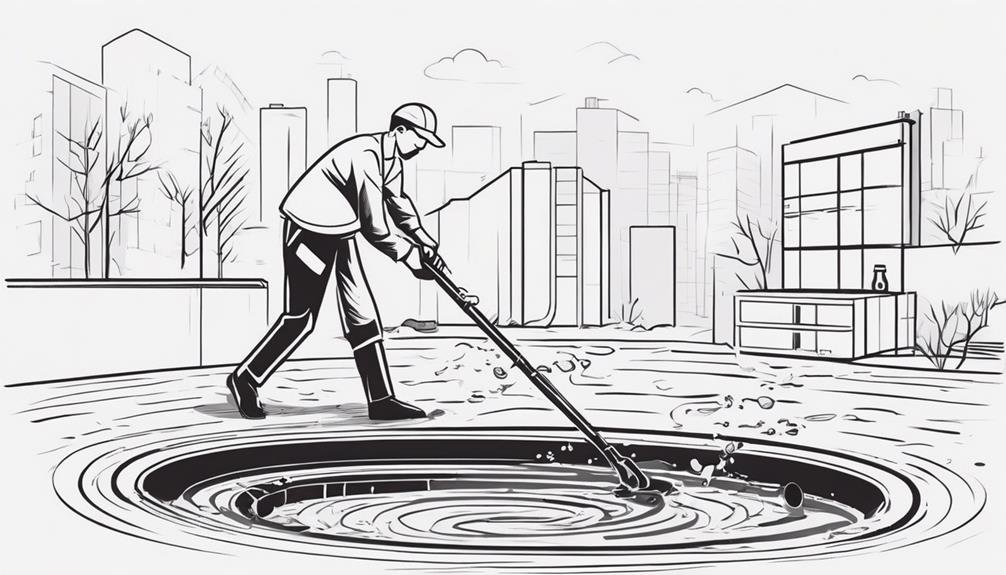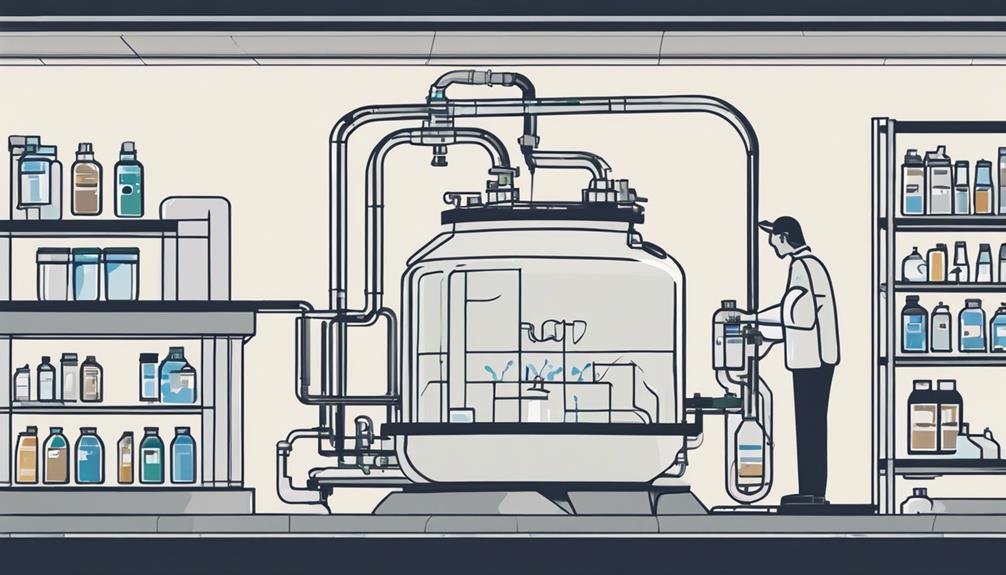When it comes to maintaining your septic tank, having the right tools is essential. From a drain snake for clearing blockages to liquid enzymes for promoting healthy bacterial growth, each tool plays a crucial role in keeping your system running smoothly.
But what about the lesser-known tools like a soil probe or an inspection camera? These items can help you detect issues before they become costly problems.
Stay tuned to discover how these tools can revolutionize your septic tank care routine.
Key Takeaways
- Drain snake prevents backup issues, crucial for maintenance.
- Soil probe analyzes soil for effective care, saves time.
- Sludge pump ensures thorough tank cleaning, essential for maintenance.
- Inspection camera identifies issues early, saves time and money.
Drain Snake

To keep your septic system running smoothly, regularly use a drain snake to clear out any clogs in your pipes. Plumbing maintenance is crucial for the well-being of your septic system. By incorporating the drain snake into your routine, you can prevent clogs and blockages that may lead to more significant issues down the line.
Clog prevention is a key aspect of septic tank care. Using a drain snake allows you to physically break up and remove debris that could cause a backup in your pipes. By proactively addressing potential clogs, you can avoid costly repairs and maintain the efficiency of your septic system.
Make sure to choose a drain snake that's appropriate for the size of your pipes and the severity of the clogs you're facing. Regularly using this tool as part of your plumbing maintenance routine will help ensure that your septic system operates smoothly and efficiently.
Septic Tank Treatment
Regularly treating your septic tank is essential for maintaining its optimal functionality and preventing potential issues. When it comes to DIY maintenance, effective treatments are key to keeping your septic system running smoothly.
Here are three items to consider for septic tank treatment:
- Bacterial Additives: Introducing beneficial bacteria into your septic tank can help break down solid waste and prevent clogs, promoting a healthier system overall.
- Oxygen Release Compounds: These treatments provide oxygen to the septic tank, aiding in the decomposition of organic matter and reducing unpleasant odors.
- Enzyme Products: Enzyme-based treatments can assist in breaking down grease, proteins, and other substances that may accumulate in the tank, improving its efficiency.
Soil Probe

When it comes to maintaining your septic tank, a soil probe can be a valuable tool.
By using a soil probe, you can measure the depth of your soil and analyze its composition.
This information is crucial in understanding how well your septic system is functioning and if any adjustments need to be made.
Depth Measurement
For accurate depth measurements of your septic tank, consider utilizing a soil probe. When it comes to maintaining your septic tank and monitoring water levels, a soil probe can be a valuable tool. Here are three reasons why you should incorporate a soil probe into your DIY septic tank care routine:
- Easy to Use: Soil probes are user-friendly and provide quick and accurate depth readings.
- Cost-Effective: Investing in a soil probe is a cost-effective way to monitor your septic tank's depth without professional help.
- Time-Saving: With a soil probe, you can efficiently check the depth of your septic tank whenever needed, saving you time and hassle.
Soil Composition Analysis
Consider utilizing a soil probe to analyze the soil composition around your septic tank for effective maintenance and monitoring of its condition.
Soil testing is crucial to understand the absorption capacity of the soil and ensure proper functioning of your septic system. By regularly conducting soil tests, you can identify any issues such as compaction or saturation that may impact the performance of your septic tank.
Incorporating soil composition analysis into your maintenance schedule allows you to make informed decisions about the frequency of pumping and other necessary interventions.
A soil probe is a simple tool that can provide valuable insights into the health of your septic system, helping you avoid costly repairs and ensuring the longevity of your system.
Sludge Pump
To efficiently remove accumulated sludge from your septic tank, utilizing a powerful sludge pump is essential. When it comes to maintaining your septic system, having the right tools can make all the difference. Here are three key points to consider when using a sludge pump:
- Powerful Performance: Look for a sludge pump with a high pumping capacity to effectively remove sludge buildup in your tank.
- Versatility: Opt for a sludge pump that can handle various types of sludge and debris to ensure thorough cleaning of your septic system.
- Ease of Use: Choose a sludge pump that's user-friendly and easy to operate, allowing you to efficiently clean your septic tank without unnecessary hassle.
Inspection Camera

When maintaining your septic tank, an inspection camera can be a valuable tool for detecting issues early on.
These cameras allow you to visually inspect the tank and its components without the need for extensive digging or excavation.
Camera Benefits
Enhance your septic tank maintenance with the invaluable tool of an inspection camera, providing a clear view of the system's condition.
- Identify Issues Early: Catch problems before they escalate, saving you time and money.
- Ensure Proper Drainage: Verify that your drainage system is working efficiently to prevent backups.
- Monitor Tank Buildup: Keep an eye on sludge levels to schedule timely pump-outs and avoid overflows.
Using a camera inspection for maintenance techniques allows you to stay proactive and address septic tank issues promptly. By incorporating this tool into your routine, you can maintain a healthy septic system and prevent costly repairs.
Inspection Tips
Use an inspection camera to gain a clear view of your septic tank's condition and identify potential issues early on. Regular inspection is crucial for maintaining a healthy septic system.
By investing in an inspection camera, you can visually assess the interior of your tank without the need for costly professional services. Make sure to familiarize yourself with how to properly use the camera through inspector training or user manuals.
Conduct inspections according to a set maintenance schedule to catch any problems before they escalate. This proactive approach can save you time and money in the long run by preventing major septic issues.
Stay ahead of maintenance by incorporating an inspection camera into your DIY septic tank care routine.
Rake
Consider incorporating a sturdy rake into your DIY septic tank maintenance toolkit to effectively remove surface debris and prevent clogs. A rake can be a versatile tool for septic tank care, offering benefits beyond just leaf removal. Here are some key reasons why a rake is essential for septic tank maintenance:
- Soil Aeration: Using a rake to gently loosen the soil around your septic tank allows for better air circulation. This process promotes the growth of beneficial bacteria that aid in breaking down waste efficiently.
- Root Removal: Rakes can help you clear out roots that may be encroaching on your septic tank system. By regularly raking the area, you can prevent roots from causing damage to the tank or blocking drainage pipes.
- Debris Management: Rakes are excellent tools for clearing away surface debris such as leaves, twigs, and other organic matter that can potentially clog your septic system. Regularly raking the area around your tank can help maintain proper functioning and prevent costly repairs.
Liquid Enzymes

How can liquid enzymes benefit your DIY septic tank maintenance routine?
Liquid enzymes play a crucial role in breaking down organic waste and maintaining a healthy balance of bacteria in your septic system. Their effectiveness lies in their ability to accelerate the decomposition of solids, oils, fats, and greases that accumulate in the tank over time. By introducing these enzymes regularly into your septic system, you can prevent clogs, odors, and backups, ultimately extending the lifespan of your tank.
When it comes to DIY application, using liquid enzymes is simple and convenient. You can easily pour the recommended amount directly into your drains or toilets and let the enzymes work their magic within your septic system. Regular applications, typically monthly, can help ensure that your septic tank operates efficiently and minimizes the need for costly maintenance or repairs.
With liquid enzymes as part of your maintenance routine, you can proactively care for your septic system and enjoy peace of mind knowing that it's functioning optimally.
Frequently Asked Questions
How Often Should I Have My Septic Tank Inspected by a Professional?
You should have your septic tank inspected by a professional every 3-5 years to ensure proper functioning. DIY inspection and maintenance can help between professional visits. Regular septic tank pumping is also recommended for efficient operation.
Can I Use Regular Household Cleaning Products in My Septic Tank?
You shouldn't use regular household cleaning products in your septic tank. Instead, opt for eco-friendly alternatives to avoid harmful chemicals. Protect your system by choosing products that won't disrupt its delicate balance and keep it functioning smoothly.
Is It Safe to Use a Pressure Washer to Clean My Septic Tank?
Using a pressure washer for septic tank cleaning can be risky. The high-pressure water may damage the system and disrupt the delicate balance of bacteria. Stick to safer DIY maintenance tools for optimal results.
How Can I Tell if My Septic Tank Is Leaking?
To check for a septic tank leak, look for soggy areas or foul odors near the tank. Perform routine septic tank maintenance to prevent leaks. Keep an eye out for any sudden changes in your yard's landscape.
What Are Some Common Signs of a Septic Tank Backup?
To prevent septic tank backups, watch for signs like slow drains, gurgling sounds, or sewage odors. DIY solutions include regular pumping, avoiding flushing harmful items, and maintaining your drain field. Stay proactive to avoid costly repairs.
Conclusion
In caring for your septic tank, remember that just like tending to a garden requires the right tools, maintaining your septic system also demands the proper equipment.
By using the best tools for DIY septic tank care, you can ensure a healthy and efficient system that will continue to serve you well for years to come.
So grab your tools and get to work, nurturing your septic tank like you'd a thriving garden.

